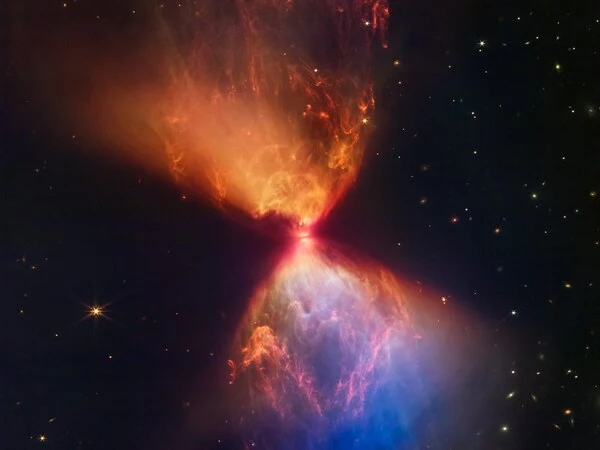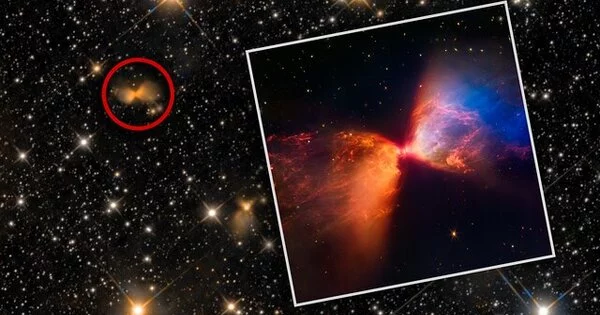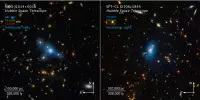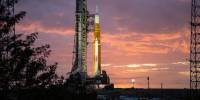The James Webb Space Telescope (Webb) will observe the Universe at wavelengths longer than visible light, in the near-infrared and mid-infrared. Webb will open a new window into the cosmos by viewing the Universe at infrared wavelengths with unprecedented sensitivity. It is possible to see the first stars and galaxies forming after the Big Bang using infrared wavelengths. Webb can also study stars and planetary systems that are forming inside thick clouds of gas and dust that are opaque to visible light thanks to its infrared vision.
The once-hidden features of the protostar within the dark cloud L1527 have been revealed by NASA’s James Webb Space Telescope, providing insight into the birth of a new star. These blazing clouds within the Taurus star-forming region are only visible in infrared light, making it an ideal target for Webb’s Near-Infrared Camera (NIRCam).
The protostar is hidden from view within the “neck” of this hourglass shape. A dark line across the middle of the neck represents an edge-on protoplanetary disk. Light from the protostar leaks above and below this disk, illuminating cavities within the surrounding gas and dust.
The once-hidden features of the protostar within the dark cloud L1527 have been revealed by NASA’s James Webb Space Telescope, providing insight into the birth of a new star.
The region’s most prominent features, the clouds colored blue and orange in this representative-color infrared image, outline cavities formed as material shoots away from the protostar and collides with surrounding matter. The colors are caused by layers of dust between Webb and the clouds. The blue areas are where the dust is thinnest. The thicker the layer of dust, the less blue light can escape, resulting in pockets of orange.
Webb also reveals filaments of molecular hydrogen that have been shocked as the protostar ejects material away from it. Shocks and turbulence inhibit the formation of new stars, which would otherwise form all throughout the cloud. As a result, the protostar dominates the space, taking much of the material for itself.
Despite the chaos that L1527 causes, it’s only about 100,000 years old – a relatively young body. Given its age and its brightness in far-infrared light as observed by missions like the Infrared Astronomical Satellite, L1527 is considered a class 0 protostar, the earliest stage of star formation.

Protostars like these, which are still cocooned in a dark cloud of dust and gas, have a long way to go before they become full-fledged stars. L1527 doesn’t generate its own energy through nuclear fusion of hydrogen yet, an essential characteristic of stars. Its shape, while mostly spherical, is also unstable, taking the form of a small, hot, and puffy clump of gas somewhere between 20 and 40% the mass of our Sun.
As the protostar gains mass, its core gradually compresses and approaches stable nuclear fusion. L1527 is doing exactly that in the scene depicted in this image. The surrounding molecular cloud is made up of dense dust and gas that is being drawn to the protostar’s center. The material spirals around the center as it falls in. This results in the formation of a dense disk of material known as an accretion disk, which feeds material to the protostar. The temperature of its core will rise as it gains mass and compresses further, eventually reaching the threshold for nuclear fusion to begin.
The disk, visible as a dark band in front of the bright center in the image, is roughly the size of our solar system. Given the density, it’s not uncommon for much of this material to clump together, forming planets. Finally, this view of L1527 provides a glimpse into the early days of our Sun and solar system.
The sunshield of the James Webb Space Telescope (JWST) is a passive thermal control system that is deployed after launch to protect the telescope and instrumentation from the light and heat of the Sun, Earth, and Moon. It allows the telescope and instruments to cool to their design temperature of 40 kelvins (−233 °C; −388 °F) by keeping them in permanent shadow. Its intricate deployment was successfully completed on January 4, 2022, ten days after launch, when it was more than 0.8 million kilometers (500,000 mi) away from Earth.
















